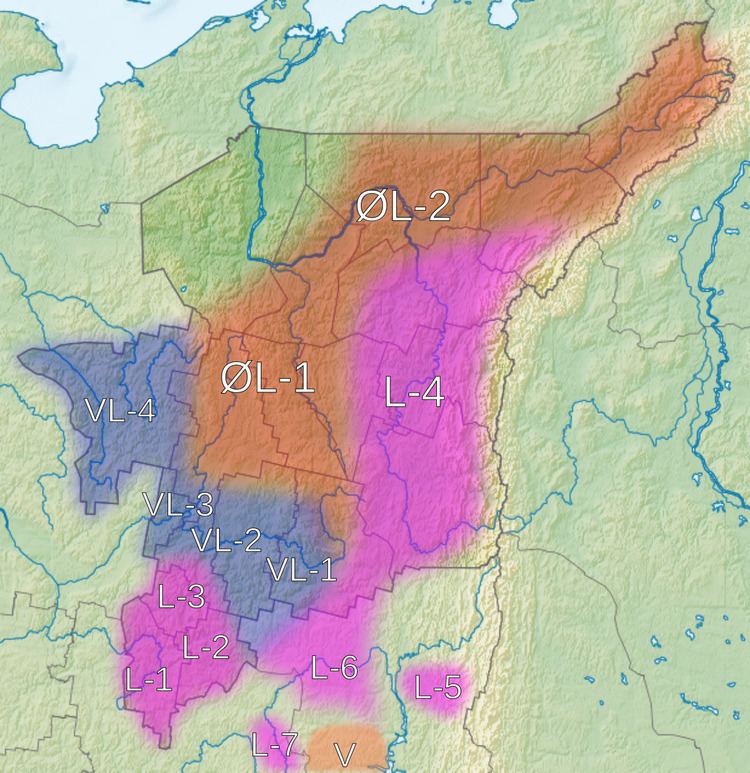Native speakers 220,000 (2010 census) | Ethnicity Komis Language family UralicPermicKomi | |
 | ||
Region Komi Republic, Perm Krai (Komi-Permyak Okrug, Krasnovishersky District), Kirov oblast (Afanasyevsky District) Dialects Komi-ZyrianKomi-PermyakKomi-Yodzyak | ||
The Komi language (Komi: Коми кыв, transliteration: Komi kyv /komi kɨv/) is a Uralic macrolanguage spoken by the Komi peoples in the northeastern European part of Russia. Komi may be considered a single language with several dialects, or a group of closely related languages, making up one of the two branches of the Permic branch of the family. The other Permic language is Udmurt, to which Komi is closely related.
Contents
Of the several Komi dialects or languages, two major varieties are recognized, closely related to one another: Komi-Zyrian, the largest group, serves as the literary basis within the Komi Republic; and Komi-Permyak (also called Permyak), spoken in Komi-Permyak Okrug, where it has literary status. A third variety, Komi-Yodzyak is spoken by a small, isolated group of Komi to the north-west of Perm Krai and south of the Komi Republic.
Writing system
The first writing system, the Old Permic script, was invented in the 14th century by the missionary Stepan Khrap, apparently of a Komi mother in Veliky Ustyug. The alphabet shows some similarity to medieval Greek and Cyrillic. In the 16th century this alphabet was replaced by the Russian alphabet with certain modifications for affricates. In the 1920s, the language was written in Molodtsov alphabet, also derived from Cyrillic. In the 1930s it was switched to Latin. Since the 1940s the Komi alphabet was simply changed to the Russian alphabet, albeit with the addition of І, і and Ӧ, ӧ.
Letters particular to the Molodtsov alphabet include ԁ, ԃ, ԅ, ԇ, ԉ, ԋ, ԍ, ԏ, where the hooks represent palatalization.
In addition, the letters Ф ф, Х х, and Ц ц might be used for words borrowed from Russian.
The first book published in Komi was a vaccination manual published in 1815.
Grammar
For a closer presentation, see Komi grammarKomi has seven vowels: close /i/, /ɨ/, /u/, mid /e/, /ɘ/, /o/ and low /a/. It has 17 cases, with a rich inventory of local cases. Like other Uralic languages, Komi has no gender. Verbs agree with subjects in person and number (sg/pl). Negation is expressed with an auxiliary verb, which is inflected for person, number and tense.
Komi is an agglutinative language and adheres to a subject–object–verb order.
Dialects
There are three literary standard varieties of Komi:
According to Lytkin (1966:44-49; 1976:106–115) and Teplyashina (1976:106–115) the Komi macrolanguage divided into four principal dialect groups or types depending on the development of Proto-Komi *l.
- L-type dialects (Kosa-Sysola) retain /l/ in all positions.
- Luza-Letka (L-1)
- Upper Sysola (L-2)
- Middle Sysola (L-3)
- Pechora (descended from Middle Sysola) (L-4)
- Komi-Yazva (L-5)
- Komi-Permyak
- Northern (Middle Kama) group of dialects (L-6)
- Zyuzdino (Upper Kama) dialect (L-7)
- VL-type dialects (Vychegda) vocalize syllable-final *l into /v/. This creates morphophonological alternation between /v/ and /l/ in stem-final position.
- Upper Vychegda (VL-1)
- Syktyvkar (Standard Komi-Zyrian) (VL-2)
- Lower Vychegda (VL-3)
- Udora (VL-4)
- ØL-type dialects (Izhma) also vocalize syllable-final *l, but with compensatory lengthening, resulting in a long vowel. This results in similar morphophonological altenations as in the previous group.
- Vym (ØL-1)
- Izhma (ØL-2)
- V-type dialects (Inva) vocalize *l into /v/ in all positions.
- Southern group (Standard Komi-Permyak) of dialects (V)
This division does not clearly correspond with the division into Zyrian, Permyak and Yazva dialects. Komi-Permyak itself divided into three dialects: two /l/ types, Northern (Middle Kama) and Zyuzdino (Upper Kama) and one /v/ type, Southern near Kudymkar, the capital of the Komi-Permyak Okrug.
